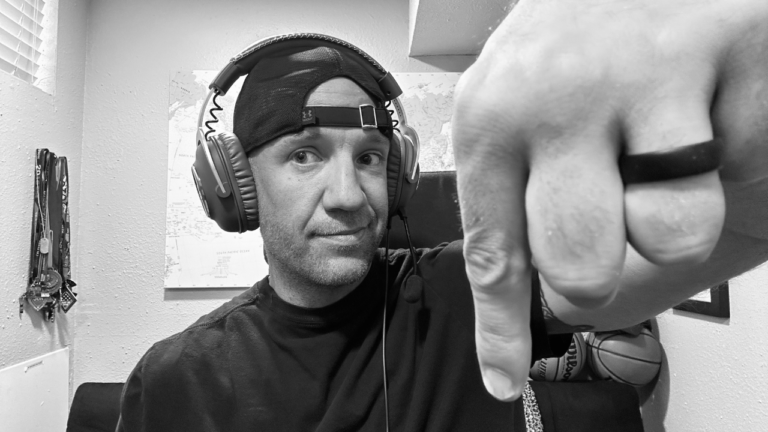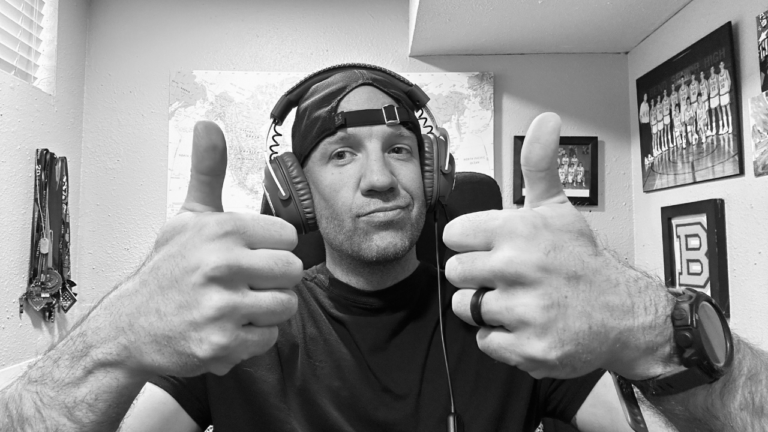about this post…
Creating a marketing podcast is easy. Staying consistent with a podcast is not.
This is Jesse, in 2023 I was invited as a guest to three different marketing podcasts that were launched in Q1. Due to lack of strategy and focus, those three podcasts no longer existed by Q2 2023.
In this blogpost, I will go over all the fundamentals of creating and continuing a successful marketing podcast.

here is the boring stuff, feel free to scroll down… 😉
In the digital age, podcasts have undoubtedly become a popular medium for businesses to promote their brand, educate their audience, and ultimately drive sales. As a marketing strategy, a podcast can offer a unique way to connect with your target market, build credibility, and position yourself as an industry expert. But where do you start? In this guide, we will walk you through the essential steps for creating a successful marketing podcast that will help elevate your business.
A marketing podcast is a series of audio episodes that are distributed online and can be downloaded and listened to at the listener’s convenience. Unlike traditional radio, podcasts offer businesses the ability to have complete control over the content they create, with an unlimited reach globally.
Podcasts have become increasingly popular in recent years, with millions of people tuning in to listen to their favorite shows. As a result, businesses have recognized the potential of podcasts as a marketing tool to reach their target audience.
The purpose of a marketing podcast is to showcase your brand and establish trust with your audience. This could be through interviewing experts, telling stories, discussing industry insights, or providing helpful tips and advice. Essentially, the podcast should offer value to the listener that they cannot find elsewhere.
For example, if you are a marketing agency, you might create a podcast that discusses the latest trends in digital marketing, provides case studies of successful campaigns, and interviews industry experts to offer insights and advice to your listeners. By doing so, you are positioning your brand as a thought leader in the industry and building trust with your audience.
Not only does creating a podcast offer the potential for increased brand awareness, but it can also lead to increased leads and sales. A high-quality podcast with engaging content has the ability to attract new customers, retain existing ones, and provide listeners with the opportunity to establish a personal connection with your brand.
Furthermore, podcasts can be a cost-effective marketing tool. While there may be some initial investment in equipment and production, once you have established your podcast, it can be a relatively low-cost way to reach your target audience. Additionally, podcasts can be repurposed into other forms of content, such as blog posts or social media content, which can further extend their reach.
Overall, a marketing podcast can be a valuable addition to your marketing strategy. By creating engaging content that offers value to your listeners, you can establish your brand as a thought leader in your industry and build trust with your audience, ultimately leading to increased leads and sales.

ok, here’s the good stuff… 🙂
Before diving into the technical aspects of podcast creation, it’s important to define your podcast’s purpose and target audience. This will help guide the direction of your content and ensure that it resonates with the right listeners.
When it comes to setting goals for your podcast, it’s important to think beyond simply creating content. While creating engaging, high-quality content is important, you should also consider how your podcast fits into your overall marketing strategy. Are you looking to increase brand awareness or drive traffic to your website? Or do you have a specific product or service you want to promote? By setting clear goals for your podcast, you can measure its success and ensure that it’s contributing to your overall business objectives.
For example, if you’re a fitness coach who specializes in helping people lose weight, your podcast might focus on topics like healthy eating, exercise, and mindset. Your goal might be to attract new clients to your coaching program, so you might include calls to action in your podcast episodes that encourage listeners to visit your website or sign up for a free consultation.
Once you’ve defined your podcast’s goals, it’s time to think about your ideal listener. Who is your podcast for? What kind of person are you trying to reach?
When identifying your ideal listener, it’s important to consider factors like age, gender, profession, interests, and location. For example, if you’re a business coach who specializes in helping women entrepreneurs, your ideal listener might be a female business owner between the ages of 25 and 45 who is interested in personal development and entrepreneurship.
Understanding your ideal listener is key to creating content that resonates with them. By knowing their interests, pain points, and what they’re looking for in a podcast, you can tailor your content to meet their needs and provide value.
For example, if your ideal listener is a busy mom who wants to start a side hustle, your podcast might focus on topics like time management, productivity, and starting a business on a budget. By providing practical tips and advice that speaks directly to your ideal listener, you can build a loyal audience who will tune in to every episode.
In summary, defining your podcast’s purpose and target audience is essential to creating a successful podcast. By setting clear goals and identifying your ideal listener, you can create content that resonates with your audience and helps you achieve your business objectives.

“For me this is constantly evolving.
At first, the brands and brews marketing podcast was for professional marketers, then we switched focus to emerging marketers. These two groups are still part of the podcast today but we now speak to anyone with an interest in marketing and of course, has a taste for beer. Typically, you want to niche down and honestly, I’ve kind of done the opposite. However, at some point I will niche down again when my goals change – which they will.
My current goal for the podcast is to network with fellow marketers and business owners to help grow my personal brand. So far, I am crushing this goal. 🙂 I’ve met many great marketers and business leaders through the podcast and have generated some customers for my consulting business and my agency.
A marketing podcast can be for other marketers, business owners, students, and the list goes on. Just understand that the best practice is to have a goal and specific audience to talk to.”

“I started the Good Beer Matters as a means to educate myself and share what I learn from others. Now in its 6th year, it has become a vehicle that connects me with professionals and enthusiasts around the world. If you’re thinking about starting a podcast, the goal for today is to just start. The goal for tomorrow is improve.”
Jeremy Storton,
Good Beer Matters Podcast
Beyond the purpose and target audience, planning engaging and relevant content is crucial to keeping your listeners engaged and coming back for more. However, creating content that resonates with your target audience can be challenging.
To help you create content that resonates with your audience, here are some tips to consider:
There are many different formats to choose from when it comes to podcasting, including interviews, solo shows, and roundtable discussions. It’s important to choose a format that aligns with your brand and message. For instance, if you’re a business coach targeting entrepreneurs, solo shows may be ideal for sharing your expertise and insights. On the other hand, if you’re a marketing consultant, interviews with other marketing experts may be more appropriate.
In addition, you must consider the length of your episodes. While some listeners may prefer shorter episodes, others may prefer longer ones. Typically, podcast episodes are between 15-60 minutes long, catering to the listener’s attention span. However, the length of your episodes may vary depending on your industry and target audience.
When planning your content, it’s essential to research your industry and your target audience. Ask yourself what questions they may have, what topics are relevant, and what would be helpful for them to know. Consider frequenting online forums or social media groups within the industry for inspiration.
For example, if you’re a fitness coach targeting women in their 30s, you may want to create content around topics such as healthy meal planning, the benefits of strength training, and how to stay motivated to exercise.
A content calendar is a great way to stay organized and consistent with your releases. By planning the themes, topics, and guests in advance, you can manage your time effectively, stay on track, and reduce the stress that comes with last-minute planning.
When creating your content calendar, consider the time of year and any upcoming events or holidays that may be relevant to your audience. For instance, if you’re a travel blogger, you may want to create content around summer vacation planning or holiday travel tips.
Remember, creating engaging and relevant content takes time and effort. By planning your content in advance and staying organized, you can create a podcast that resonates with your target audience and keeps them coming back for more.

“So, this took me a while to figure out.
I enjoy-long form content because it allows the listener to listen in intervals. For example, it might listen at 30 minute intervals for a three hour Joe Rogan podcast.
However, I quickly learned that editing process can be a nightmare so I try to keep my podcasts to 30 to 60 minutes. By season two, my content was all about my guests.
Instead of creating a content calendar, I have guest calendar. Each guest brings their own level of expertise and I try not to have the same type of guest (SEO specialist example) back-to-back. My guest calendar is usually around five to seven people deep.
So, with a weekly podcast, I typically plan about six weeks out. I meet with each guest before the podcast and narrow down the topic and some potential core conversations.
Podcasting is all about consistency. Planning out your content is key to keeping your pod alive and running.”
Paying attention to technical details, such as sound quality, editing, and promotion, is essential for a successful podcast.
A high-quality microphone, headphones, recording software or hardware, and editing software are essential. It’s important to note that you do not have to spend a fortune on professional equipment. It is possible to achieve excellent sound quality at an affordable price.
Careful recording and editing can take your podcast from amateur to professional. Creating an outline, rehearsing, and projecting your voice are some tips to keep in mind when recording. When editing, removing unwanted noise, tightening up pauses, and adding music are some essential steps to follow.
An intro and outro help establish brand recognition, and is an excellent opportunity to showcase your brand and convey the tone of the episode. It’s essential to choose music that aligns with your brand and message.

“Production almost made me quit podcasting.
I hate it.
I’ve had numerous problems with equipment. Endless problems with my software. And, editing is the absolute worse. All of this for me was a steep learning curve and honestly, I’m still learning.
I finally had an IT friend help me troubleshoot my equipment and software – huge relief.
And, now I hire somebody to do the editing for me – game changer.
If your new to sound and even video production, then expect a learning curve. My advice is to find help!”

“I got this.
Technical Aspects of Podcast Production
Paying attention to technical details, such as sound quality, editing, and promotion, is essential for a successful podcast. As a podcaster you are selling SOUND, so you want to make sure your sound is both unique but also high quality. Nothing worse than listening to a podcast and hearing a bunch of noise, or someone on a poor quality headset. Like any other product – if you want to succeed, you need to focus on product quality. Here are some tips for creating an awesome, and unique, podcast sound.
Essential Podcasting Equipment
A high-quality microphone, headphones, recording software or hardware, and editing software are essential. It’s important to note that you do not have to spend a fortune on professional equipment. It is possible to achieve excellent sound quality at an affordable price. While we use a variety of tools because of Kirill’s background in music production and sound editing, such as FL Studio with various plugins, you don’t need to spend $1,000+ on your hardware and software. Audacity is a great open source (read free, but also great quality) tool for sound editing. With a few basic YouTube tutorials you can edit the sound quality of your podcast and create consistency in your mix and sound. If you want to get more advanced, you can even add sound effects, and explore some sound effect options to make your podcast stand out in the crowd. You do want to make sure you invest in a reasonably good headset or microphone, and record in a quiet environment. You don’t necessarily need to add soundproofing or dampening to your recording environment but it doesn’t hurt, and can be done at a very reasonable cost.
Recording and Editing Tips for High-Quality Audio
Careful recording and editing can take your podcast from amateur to professional. Creating an outline, rehearsing, and projecting your voice are some tips to keep in mind when recording. When editing, removing unwanted noise, tightening up pauses, and adding music are some essential steps to follow. If you have a more advanced audio editing tool, such as FL Studio, ProTools, and probably some web recording tools we just don’t know, you can create audio mix presets which you can then use to create consistency in your sound without spending hours editing each episode. Some examples include dampening or amplifying certain frequencies in your episodes to make your podcast sound great on a variety of sound devices, but also taking into account that most people are going to listen in their car, in a headset or earbuds, or on stereo speakers. Don’t skip this sound editing part. Just like great films, great podcasts can live or die by the quality of their sound. Nothing worse than finding a great podcast you can’t listen too because one episode is super loud, the next is super quiet, and the third has a bunch of static noise in the background.
Adding Intro and Outro Music
An intro and outro help establish brand recognition, and is an excellent opportunity to showcase your brand and convey the tone of the episode. It’s essential to choose music that aligns with your brand and message. If you have the ability to produce your own music or sounds – this creates a totally unique vibe. If you are just picking “free stock music” you risk sounding like everyone else, and losing the unique flavor that makes your podcast yours. If you don’t have the skill to create your own sound, find someone on Fiverr, or reddit, or many other places who will be happy to help you out. Kirill has done some intros for YouTube shows, ads, and film, and created the intro and outro for Brands and Brews. Try to stay consistent with your sound because you want fans to look forward to hearing your intro, it can get them excited about what’s to come, like the first few seconds of the Sopranos or Curb Your Enthusiasm theme.”
Kirill Knizvez,
Cohost of the Brands and Brews Marketing Podcast
Promotion is critical for growing your audience, engagement, and ultimately the success of your podcast.
Promoting your podcast on social media accounts and email newsletters can help reach a broader audience. Creating attractive graphics, using hashtags, and announcing new episodes are some strategies to stay top of mind with your listeners.
Collaborating with industry experts or influencers in your niche can help increase your reach, establish credibility, and attract a new audience. Inviting guests onto your show is also an excellent way to vary your content and provide different points of view.
Engage with your listeners by responding to their comments, offering Q&A sessions, or polls. Encouraging your listeners to leave reviews not only helps boost your credibility, but it also increases your visibility on platforms like Apple Podcasts, Spotify, and Google Play.

“Don’t treat your podcast like the field of dreams, be aggressive with the growth.
Share clips of it on social, add it to the confirmation page of your scheduling calendar, ask your network to leave a review on streaming platforms, and refer to it during sales calls for prospective clients to listen to to help solve their problems.
You have to be the biggest fan of your podcast and go after every opportunity you can to get it out there.“

“Whether you’re marketing podcast is managed by a company or solo (like mine), we all have a limit amount of resources.
For me, I have to run this podcast very lean from A-Z. Therefore, I have to be very specific with what and how I promote my pod to get the most out of it. I write brief blogposts on my website for each episode and promote them on LinkedIn. I also, create 1-2 short videos for each episode and also post those on LinkedIn.
Interviewing guests that have a strong following has also helped expand the pod.
The key here is consistency.
Whatever you plan is, make sure it’s realistic to achieve on a consistent basis.”
Example of LinkedIn post:
Creating a marketing podcast doesn’t have to be complicated, but it does require careful planning and execution. By following the essential steps outlined above, you can create a podcast that resonates with your audience and adds value to your brand.